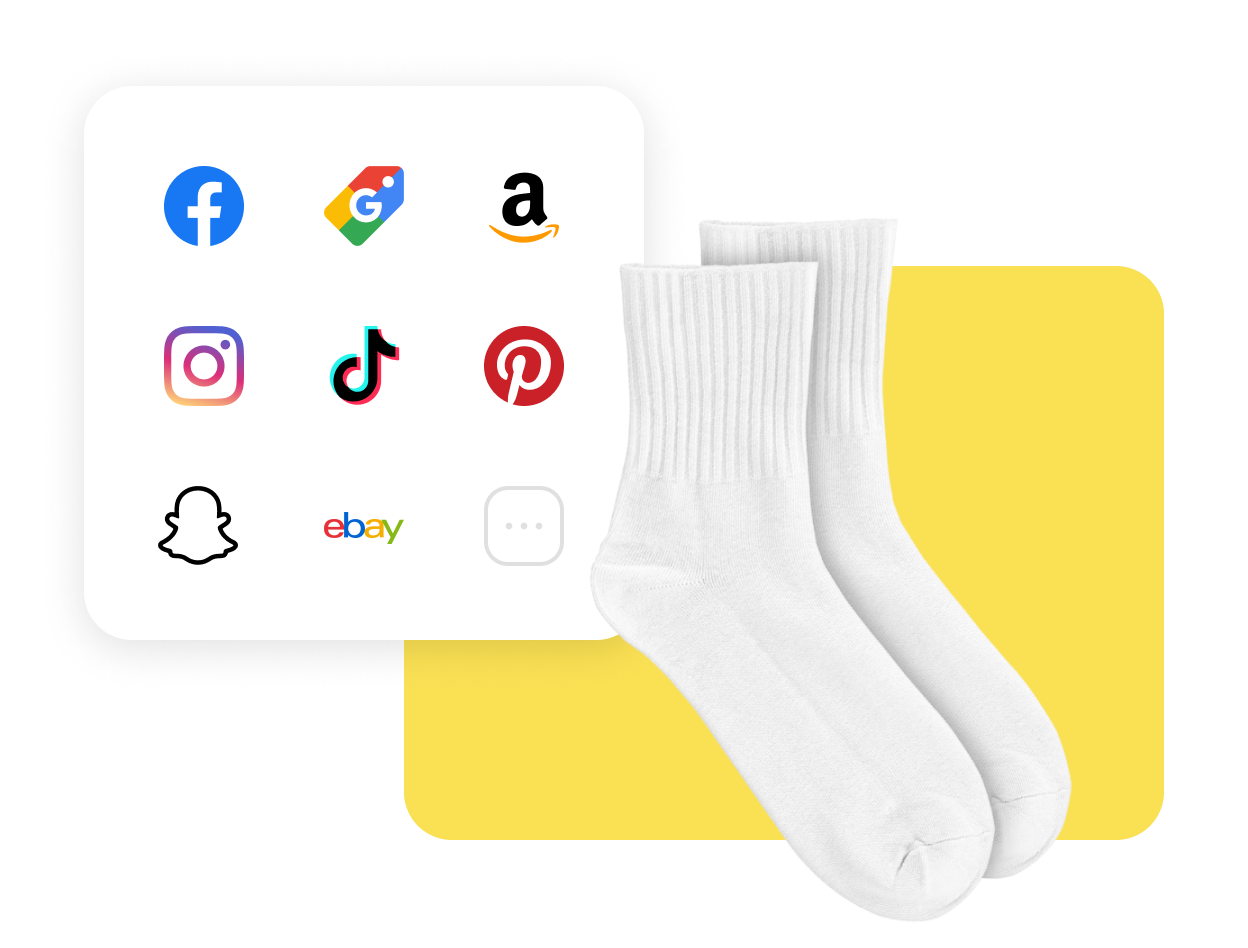Does the inside of your closet look like a clothing boutique? Do you have an eye for great pieces and upcoming trends? Do you just want to make some extra money by selling clothes online? Whatever the case, if you need a website for your clothing business, we’re here to help. This guide will give you step-by-step information on how to create a website to sell clothes.
Being able to put together the perfect look doesn’t mean you also have to be a tech wizard. No one can do it all! Luckily, building an online clothing store has never been simpler thanks to the many ecommerce platforms available to help.
To make things even easier, we’ve broken down the process into a handful of steps. Check them all off in one go or build your store at your own pace. With each step, you’re that much closer to your own clothing website!
1. Choose an Ecommerce Platform
Ecommerce platforms and website builders are online services that allow you to quickly and easily make a website to sell clothes (or anything else that interests you). Sites like Ecwid by Lightspeed, Squarespace, and Wix come loaded with templates that take the hard work and coding out of website building. Depending on the platform you choose, they also include a variety of features to help you customize your website and easily sell your products.
Changing your platform or website builder can be as easy as changing your clothes. It’s always a good idea to sample different options until you find the best fit for you and your clothing business. You’ll want to choose a platform that can help you create a website that looks beautiful, is easy to use, can handle the right amount of inventory, has great connectivity with social media and other marketplaces, and doesn’t break the bank.
Many platforms like Wix and Squarespace offer free trial periods that allow you to build your website and test out features. Just be sure to cancel your account before the trial expires if you’re not planning to keep the site and don’t want to be charged.
If you don’t want to deal with the hassle of a time-limited free trial, Ecwid by Lightspeed is a great option. Ecwid by Lightspeed lets you set up a free ecommerce website and keep it free indefinitely.

An example of an ecommerce website you can create for your clothing store with Ecwid by Lightspeed
2. Name Your Store
Now you need to customize your website. In terms of customization, choosing a name is one of the most important (and hopefully fun) steps! The website name catches the attention of your customers, sets the tone for their shopping experience, and lets them know what sort of items they can expect to find on your clothing website.
Do you sell both dresses and outdoor wear? Call your site Gown Fishing. Selling vintage menswear and nautical-themed clothing? Go with Old Man and the Sea. You get the point. Just make sure to have fun while you bounce ideas around. Eventually, you’ll find a name that’s both catchy and informative.
For best results, make sure your business name is:
- Short. Limit yourself to 1-2 words in the name, 2-3 syllables per word.
- Easy to pronounce and write. Avoid using silent letters. Choose words that are spelled phonetically.
- Communicating brand values. Make it relevant to your target audience by using words that describe what your customers value.
Learn more: Business Names Ideas: How to Choose the Best Store Name
For example, Hibiscus Heroes sells clothes made with plant-based fabrics dyed in colors extracted from plants. They highlight their plant-based approach in their brand name too.

The Hibiscus Heroes online store
Once you’ve settled on a name, you can purchase the domain to make your website easier to find. Most platforms come with built-in options to purchase a domain, so that you can include the name you’ve chosen in the URL rather than something generic. This way, if your customers know the name of your website, they can type it into a search engine and quickly navigate to your store.
A perfect domain name should:
- be easy to spell, pronounce, remember, and type (avoid punctuation marks, long words, etc.)
- contain your brand name or keywords relevant to your industry
- use a familiar domain extension, such as .com, .org, .net
3. Design Your Digital Storefront
Website builders and ecommerce platforms make it easy to find the perfect look for your website. You’ll be able to choose from a wide variety of templates designed to best showcase the clothing you’re selling. There is often a cost associated with the templates—especially the ones that look the best—but most platforms offer a few free options if you’re looking to keep your costs down.
Ecwid by Lightspeed has plenty of sleek, ready-made design templates that allow you to design a website to sell clothes in a couple of minutes. There are templates for different types of apparel stores so you can choose the one that suits your business the most.
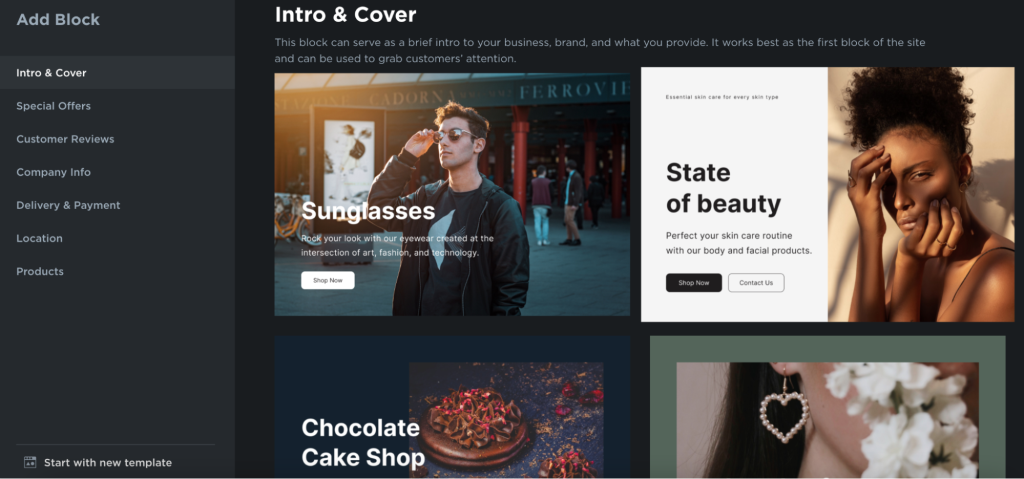
Designing a clothing store is simple with Ecwid by Lightspeed
Since most of your customers will be shopping from their mobile devices, it’s also important to make sure that your website looks good in mobile form. Ecwid by Lightspeed allows you to build and fully manage your store on your mobile device. You can create your full website, add products, manage orders and inventory, and more from the same view that your customers will be getting.
4. Upload Your Inventory
While seemingly simple, uploading inventory should be done thoughtfully. Try imagining your clothing website as the sales floor of your favorite retail store. Is it cluttered or sparse? What kinds of items are front and center? Which are off to the sides? Is everything jumbled together or are items separated into categories?
Depending on your answers to these questions and your own preferences, you can easily upload your products using your platform’s built-in features. Be sure to include pictures that showcase your merchandise and detailed descriptions so customers can see what they’re buying.
For a clothing store, pictures are especially important since customers want to know what the clothes look like. Keep in mind these best practices when making pictures for your store:
- Take pictures from different angles, if possible
- Crop out any extra clothing items in the background
- Use light colors for the background in your photos
- Show clothes on models, preferably with different body types
- Add close-up pictures to let customers see the material or pattern better
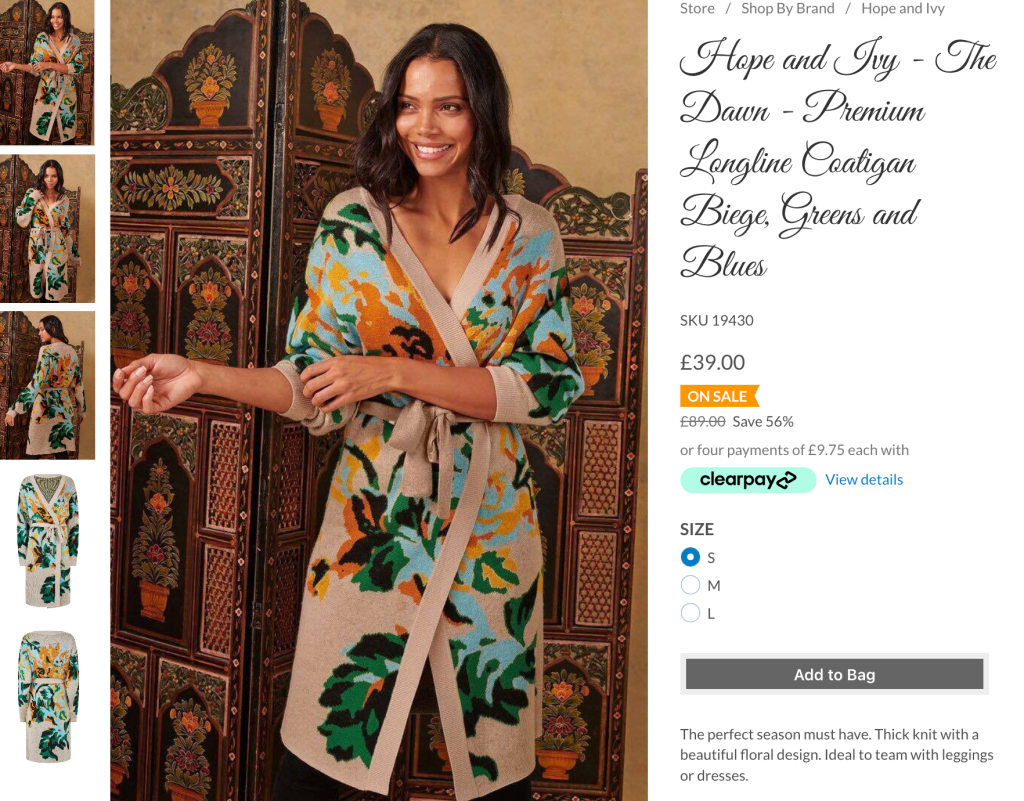
High-quality product pictures are a must for a clothing store
If you run an Ecwid store, there is a zoom-on-hover effect available for product pictures on the desktop view. Customers can view even the smallest details in your product pictures, such as material, texture, and intricate patterns.
When writing descriptions for your clothes, be sure to include all relevant clothing details. These include sizes, colors, fit, fabric, and anything else you think is important to mention. It’s also worth adding information about how to care for clothing items so customers know how to keep their clothes in great shape.
Your clothing store should also be organized in a way that makes sense for customers—for example, categorizing clothing by gender, clothing type (shirts, pants), or season. This will help customers find what they’re looking for quickly.
5. Set Up Your Payment Processor
Many website builders and ecommerce platforms have an in-house payment processing system. Most also offer connectivity to other services, like PayPal. Whatever your preference, this is not a step to skip. You want to be sure your customer’s money is finding its way into your wallet.
When choosing a payment gateway, keep in mind the following:
- Security and fraud protection. A secure payment gateway is PCI DSS-compliant and provides fraud prevention methods such as 3D Secure. Gateways may offer extra security features to protect your customers’ data.
- Payment processing fees. Most payment gateways charge a percentage and/or flat rate fee for processing each transaction. Check twice whether you can afford the gateway you want to use.
- Convenient payment options for customers. Most gateways let you accept payments in your store via credit and debit cards. However, digital wallets and other alternatives, such as Apple Pay and Google Pay, are becoming increasingly popular, so it makes sense to offer them too.
Ecwid by Lightspeed integrates with more than 100+ secure and convenient payment gateways, including PayPal, Stripe, Lightspeed Payments, and more.
6. Share Your Clothing Store
Customers won’t often just stumble upon your website by chance—you need to put some effort into getting it out there. Sharing your clothing store on social media or marketplaces helps to do just that.
You can start by creating social media pages for your business. Focus on the platforms where your target audience is located. Consider Instagram, Pinterest, and TikTok; these visual-first platforms are especially useful for promoting apparel stores.
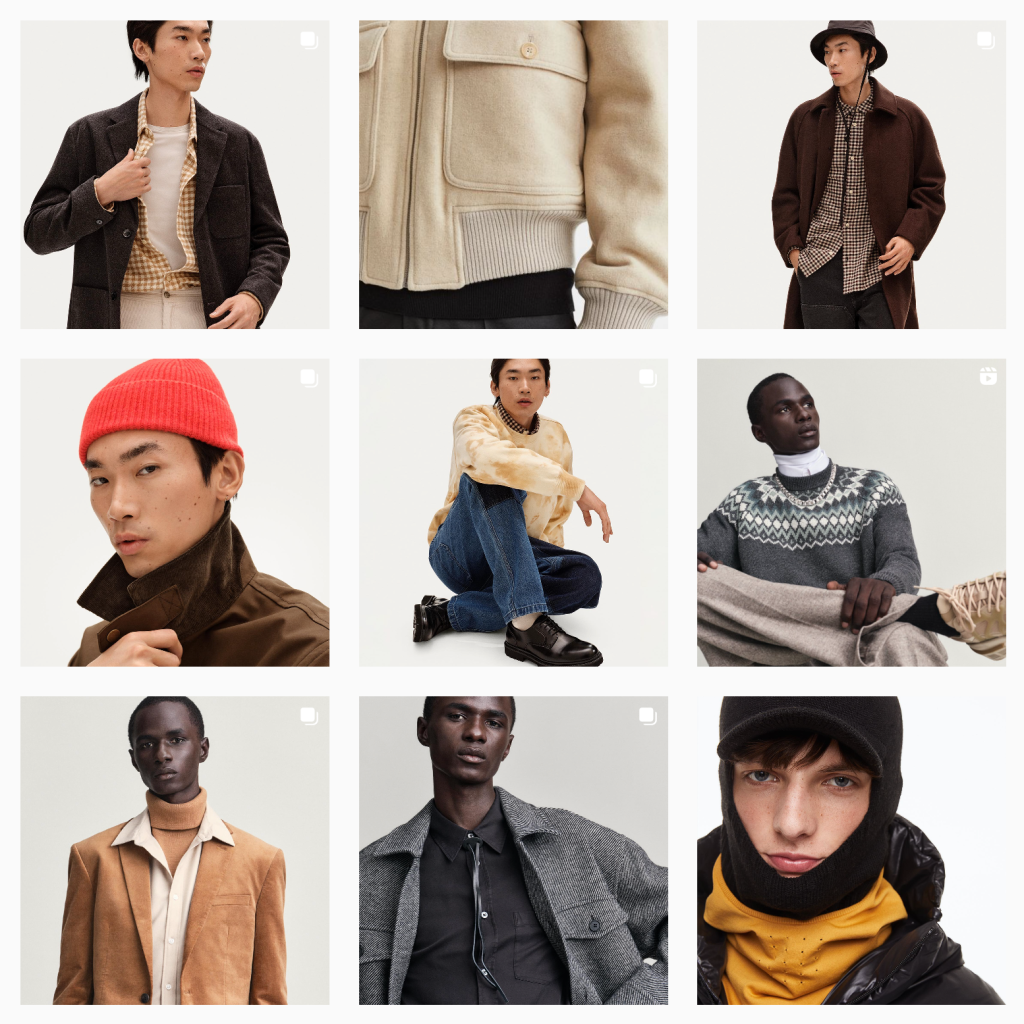
Instagram is popular among apparel brands
Share posts featuring your clothes on your business’s social media pages. You can also use social media to announce sales, new clothing lines, special events, and more.
As for marketplaces, it makes sense to advertise your products on a wide breadth of platforms because people are already looking for clothes there. However, the competition might be high, especially for popular apparel categories.
If you want to sell on social media and marketplaces, it’s important that your ecommerce platform allows you to sync your store with social media and marketplaces. This way, you spend less time setting up and managing your store on different platforms. With an integrated platform, you can run all your operations from a single dashboard.
At Ecwid by Lightspeed, you can easily sync and sell across social media and marketplaces. You can sync your Ecwid store with a platform of your choice to set up a Facebook or Instagram Shop, or become an Amazon or eBay seller.
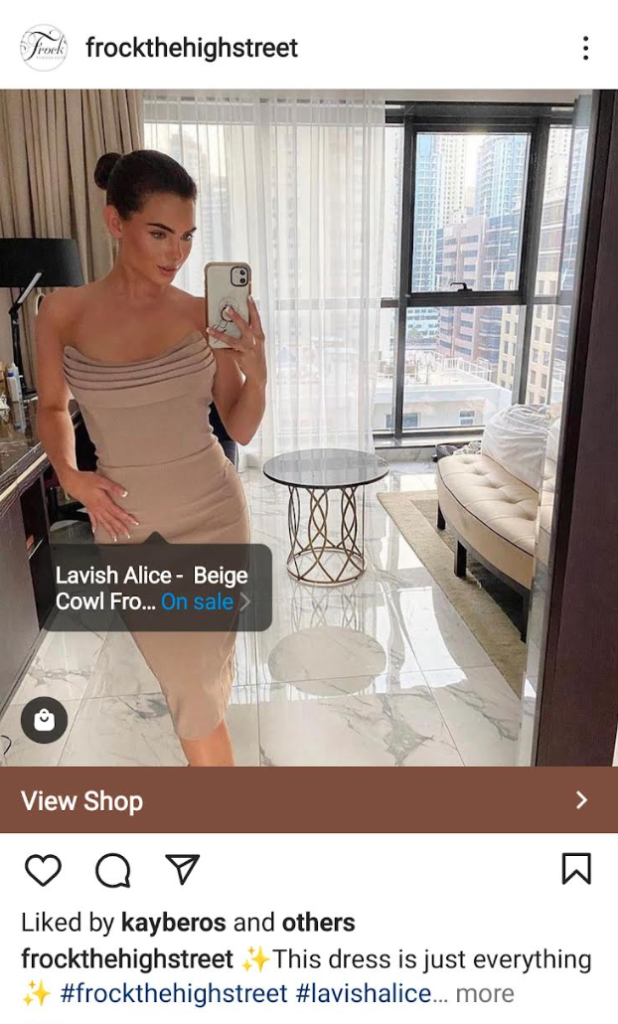
With Instagram Shop, you can let customers can buy your products right in the app
7. Promote and Sell
You’ve chosen a platform, built and customized your website, secured a domain name, added products, and figured out your preferred payment method. Congratulations, you’ve reached the final (and most important) step: selling clothes!
Now it’s time to double down on your store promotion. Here are a couple of ideas:
- Offer discounts and sales. Consider running a sale or offering a coupon code to encourage people to place their orders.
- Leverage email marketing. Email campaigns are a great way to keep your clothing store top of mind and reach potential customers. You can also use emails to announce new arrivals or promotions.
- Consider running paid ads. Google Ads and social media ads can help you reach a larger audience quickly.
- Partner with other brands or influencers. Reach out to brands or bloggers that align with your clothing store and partner up for mutual promotion.
Find more ideas for promoting your store with ecommerce marketing tips for beginners.
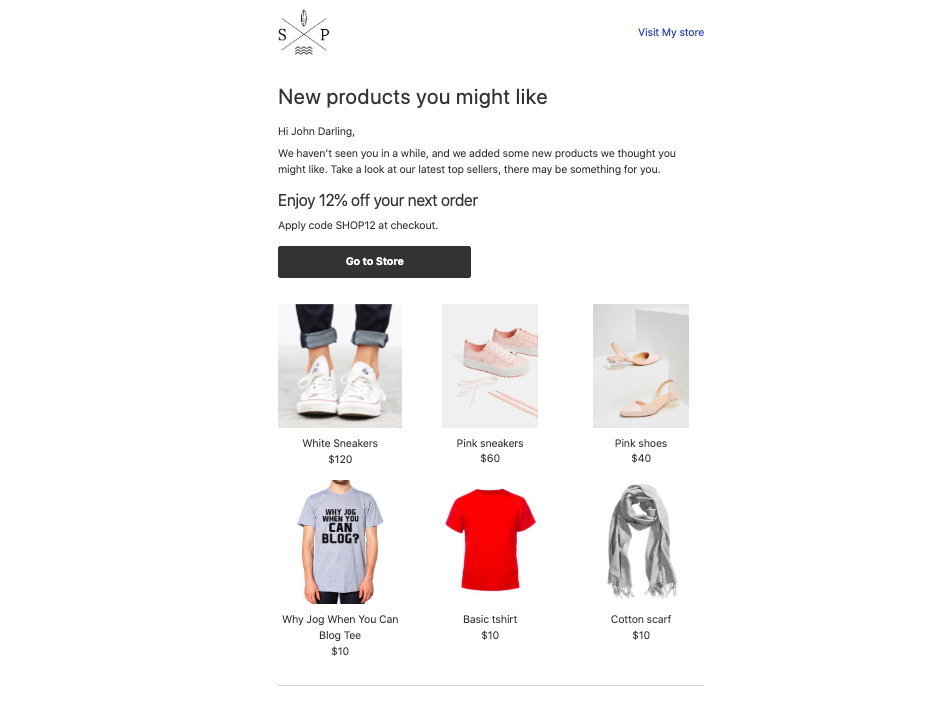
An automated marketing email you can send with Ecwid by Lightspeed
If your ecommerce platform has built-in marketing features, it makes promoting your product much easier. For example, Ecwid by Lightspeed has email marketing tools such as abandoned cart recovery and automated emails. It also allows you to promote your products through Facebook, Instagram, Google, Pinterest, and Snapchat.
Wrap Up
Creating a clothing store should come easily with the right platform, website design, and connectivity to other sites. As you sell, pay attention to which items are flying off shelves the fastest and which aren’t getting as much love. Always be ready to adjust prices and inventory to keep up with customer demands and don’t be afraid to check out what your competition is doing if you’re in need of a few ideas.
Don’t forget that if you need support, Ecwid by Lightspeed offers live customer service to help when you need it. Time to start your own clothing store!
Do you want to learn more about selling clothes online?
- SEO Powered Content & PR Distribution. Get Amplified Today.
- Platoblockchain. Web3 Metaverse Intelligence. Knowledge Amplified. Access Here.
- Source: https://www.ecwid.com/blog/create-website-to-sell-clothes.html




